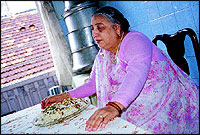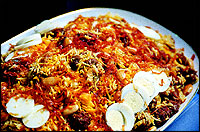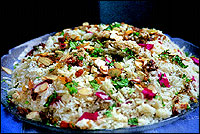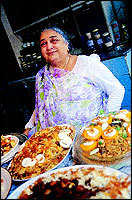|
WHY Pulaos, that�s a good question! I like making Pulaos because nowhere in the world is rice so treasured and valued as in India. I always use Basmati rice for my Pulaos, Sadhu Chaap or Lal Killa brands, both are really good. They have nice, long grains. On average days, I use Kohinoor or Trophy brand Basmati rice. I can identify the rice by the size of the grain, its texture, and smell. I can tell if it is old or new rice just by touch and smell. There was a time when I went to the grocers in the market myself to buy my rice but now a tarkariwali from Grant Road delivers my requirements at home. She gives me good stuff, her vegetables are never smashed or twisted, and they are never the cheap variety either. I have been using her for the last 30 years and she has my instructions to only give me the best.  My husband, Feroze, goes to Crawford Market for the fish and meat and the chicken is delivered home. I used to like shopping for fish at Sassoon Dock, but now it�s not possible. I get elbowed and pushed in the crowd! I always select the Rawas for my pot. It is the sweetest and best Indian fish of all. A bit like Salmon, you get nice, thick, boneless fillets from it. Then, of course, there is the Pomfret, and I also use Prawns and Lobsters. In meat, I prefer the boneless kind. Especially the leg cut with nalli. I can cut this into good size pieces and the nalli makes the meat more tasty. In chicken, the breast piece is always the better portion to eat than the leg. The leg meat is tougher. Besides, the breast is good for baking.
My husband, Feroze, goes to Crawford Market for the fish and meat and the chicken is delivered home. I used to like shopping for fish at Sassoon Dock, but now it�s not possible. I get elbowed and pushed in the crowd! I always select the Rawas for my pot. It is the sweetest and best Indian fish of all. A bit like Salmon, you get nice, thick, boneless fillets from it. Then, of course, there is the Pomfret, and I also use Prawns and Lobsters. In meat, I prefer the boneless kind. Especially the leg cut with nalli. I can cut this into good size pieces and the nalli makes the meat more tasty. In chicken, the breast piece is always the better portion to eat than the leg. The leg meat is tougher. Besides, the breast is good for baking.
 People ask me what is the difference between a Pulao and a Biryani, and to me, the basic difference is that the Pulao has quite a bit of gravy in it whereas the Biryani tends to be dry. Biryanis are just a combination of meat and rice. Mention Biryani, and people look out for chunks of meat! But in a Pulao, there is such an opportunity to be adventurous, there are so many items to chose from that you can introduce in the cooking or in the decoration and presentation stage. I use all kinds of nuts and cream, dried fruits, eggs, silver foil, fresh fruit, yogurt, I even use milk in making a Pulao sometimes.
People ask me what is the difference between a Pulao and a Biryani, and to me, the basic difference is that the Pulao has quite a bit of gravy in it whereas the Biryani tends to be dry. Biryanis are just a combination of meat and rice. Mention Biryani, and people look out for chunks of meat! But in a Pulao, there is such an opportunity to be adventurous, there are so many items to chose from that you can introduce in the cooking or in the decoration and presentation stage. I use all kinds of nuts and cream, dried fruits, eggs, silver foil, fresh fruit, yogurt, I even use milk in making a Pulao sometimes.
 I cook my Pulaos always on the gas. It is the cleanest form of cooking. But if I�m cooking for, say, a thousand people, then I use coal. My paternal grandmother, Cooverbai Frenchman, who lived in Rawalpindi, used to tell me when I was small that the most delicious foods were cooked on a slow heat. Never place your dekchi or tapeli on high heat for this will burn your gravy a lot faster than it should and the meat will remain dry and only be partially cooked. Gas doesn�t make the bartans black, dirty or greasy. It is also easier to clean the vessels afterwards. Coal spoils the vessels. It takes a lot of time and water to clean them. But, in today�s world nobody uses coal unless they have a garden for sigris and tandoors. In a modern flat, gas is the best.
I cook my Pulaos always on the gas. It is the cleanest form of cooking. But if I�m cooking for, say, a thousand people, then I use coal. My paternal grandmother, Cooverbai Frenchman, who lived in Rawalpindi, used to tell me when I was small that the most delicious foods were cooked on a slow heat. Never place your dekchi or tapeli on high heat for this will burn your gravy a lot faster than it should and the meat will remain dry and only be partially cooked. Gas doesn�t make the bartans black, dirty or greasy. It is also easier to clean the vessels afterwards. Coal spoils the vessels. It takes a lot of time and water to clean them. But, in today�s world nobody uses coal unless they have a garden for sigris and tandoors. In a modern flat, gas is the best.
Click for recipe
|



 Make Fragrant Pulaos At Home!
Make Fragrant Pulaos At Home!


 My husband, Feroze, goes to Crawford Market for the fish and meat and the chicken is delivered home. I used to like shopping for fish at Sassoon Dock, but now it�s not possible. I get elbowed and pushed in the crowd! I always select the Rawas for my pot. It is the sweetest and best Indian fish of all. A bit like Salmon, you get nice, thick, boneless fillets from it. Then, of course, there is the Pomfret, and I also use Prawns and Lobsters. In meat, I prefer the boneless kind. Especially the leg cut with nalli. I can cut this into good size pieces and the nalli makes the meat more tasty. In chicken, the breast piece is always the better portion to eat than the leg. The leg meat is tougher. Besides, the breast is good for baking.
My husband, Feroze, goes to Crawford Market for the fish and meat and the chicken is delivered home. I used to like shopping for fish at Sassoon Dock, but now it�s not possible. I get elbowed and pushed in the crowd! I always select the Rawas for my pot. It is the sweetest and best Indian fish of all. A bit like Salmon, you get nice, thick, boneless fillets from it. Then, of course, there is the Pomfret, and I also use Prawns and Lobsters. In meat, I prefer the boneless kind. Especially the leg cut with nalli. I can cut this into good size pieces and the nalli makes the meat more tasty. In chicken, the breast piece is always the better portion to eat than the leg. The leg meat is tougher. Besides, the breast is good for baking. People ask me what is the difference between a Pulao and a Biryani, and to me, the basic difference is that the Pulao has quite a bit of gravy in it whereas the Biryani tends to be dry. Biryanis are just a combination of meat and rice. Mention Biryani, and people look out for chunks of meat! But in a Pulao, there is such an opportunity to be adventurous, there are so many items to chose from that you can introduce in the cooking or in the decoration and presentation stage. I use all kinds of nuts and cream, dried fruits, eggs, silver foil, fresh fruit, yogurt, I even use milk in making a Pulao sometimes.
People ask me what is the difference between a Pulao and a Biryani, and to me, the basic difference is that the Pulao has quite a bit of gravy in it whereas the Biryani tends to be dry. Biryanis are just a combination of meat and rice. Mention Biryani, and people look out for chunks of meat! But in a Pulao, there is such an opportunity to be adventurous, there are so many items to chose from that you can introduce in the cooking or in the decoration and presentation stage. I use all kinds of nuts and cream, dried fruits, eggs, silver foil, fresh fruit, yogurt, I even use milk in making a Pulao sometimes. I cook my Pulaos always on the gas. It is the cleanest form of cooking. But if I�m cooking for, say, a thousand people, then I use coal. My paternal grandmother, Cooverbai Frenchman, who lived in Rawalpindi, used to tell me when I was small that the most delicious foods were cooked on a slow heat. Never place your dekchi or tapeli on high heat for this will burn your gravy a lot faster than it should and the meat will remain dry and only be partially cooked. Gas doesn�t make the bartans black, dirty or greasy. It is also easier to clean the vessels afterwards. Coal spoils the vessels. It takes a lot of time and water to clean them. But, in today�s world nobody uses coal unless they have a garden for sigris and tandoors. In a modern flat, gas is the best.
I cook my Pulaos always on the gas. It is the cleanest form of cooking. But if I�m cooking for, say, a thousand people, then I use coal. My paternal grandmother, Cooverbai Frenchman, who lived in Rawalpindi, used to tell me when I was small that the most delicious foods were cooked on a slow heat. Never place your dekchi or tapeli on high heat for this will burn your gravy a lot faster than it should and the meat will remain dry and only be partially cooked. Gas doesn�t make the bartans black, dirty or greasy. It is also easier to clean the vessels afterwards. Coal spoils the vessels. It takes a lot of time and water to clean them. But, in today�s world nobody uses coal unless they have a garden for sigris and tandoors. In a modern flat, gas is the best.